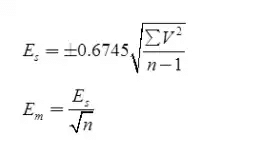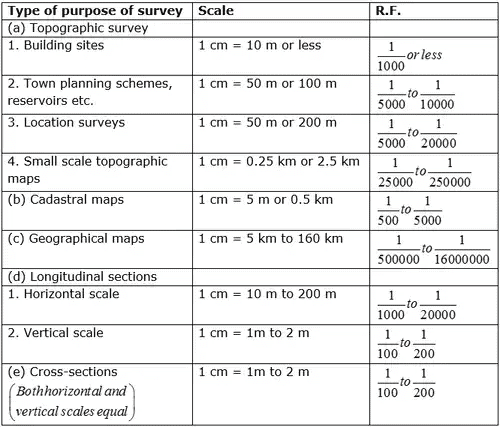Fundamental Concepts of Surveying | Geomatics Engineering (Surveying) - Civil Engineering (CE) PDF Download
Introduction
Surveying is the process of determining relative positions of different objects on the surface of the earth by measuring horizontal distances between them and preparing a map to any suitable scale. Measurements are taken in a horizontal plane.
Reconnaissance
- This is an exhaustive preliminary survey of the land to be surveyed. It may be either ground reconnaissance or aerial reconnaissance survey.
- Reconnaissance is made on arrival to site during which an overall picture or view of the area is obtained. The most suitable position of stations is selected, the purpose of the survey and the accuracy required will be drawn, and finally, the method of observation will be established.
Objectives of reconnaissance
- To ascertain the possibility of building or constructing route or track through the area.
- To choose the best one or more routes and record on a map
- To estimate probable cost and draft a report.
Principle of working from whole to part
It is a fundamental rule to always work from the whole to the part. This implies a precise control surveying as the first consideration followed by subsidiary detail surveying.
- This surveying principle involves laying down an overall system of stations whose positions are fixed to a fairly high degree of accuracy as control, and then the survey of details between the control points may be added on the frame by less elaborate methods.
- Once the overall size has been determined, the smaller areas can be surveyed in the knowledge that they must (and will if care is taken) put into the confines of the main overall frame.
- Errors which may inevitably arise are then contained within the framework of the control points and can be adjusted to it.
Types of Surveying
On the basis of whether the curvature of the earth is taken into account or not, surveying can be divided into two main categories:
- Plane Surveying
Plane surveying is that type of surveying in which the mean surface of the earth is considered as a plane and the spheroidal shape is neglected.
All angles are considered to be plane angles. For small areas less than 250 km2 plane surveying can safely be used. For most engineering projects such as canal, railway, highway, building, pipeline, etc constructions, this type of surveying is used. It is worth noting that the difference between an arc distance of 18.5 km and the subtended chord lying in the earth’s surface is 7mm. It is divided into three branches.
(i) Cadastral surveying
(ii) Topographical surveying
(iii) Engineering surveying - Geodetic Surveying
It is that branch of surveying, which takes into account the true shape of the earth (Ge-oid).
Classification Of Surveying
Surveying is classified based on various criteria including the instruments used, purpose, the area surveyed and the method used.
- Classification on the Basis of Instruments Used: Based on the instrument used; surveys can be classified into;
(i) Chain tape surveys
(ii) Compass surveys
(iii) Plane table surveys
(iv) Theodolite surveys - Classification based on the surface and the area surveyed
(i) Land survey: Land surveys are done for objects on the surface of the earth. It can be subdivided into:
(a) Topographic survey: This is for depicting the (hills, valleys, mountains, rivers, etc) and manmade features (roads, houses, settlements…) on the surface of the earth.
(b) Cadastral survey is used to determining property boundaries including those of fields, houses, plots of land, etc.
(c) Engineering survey is used to acquire the required data for the planning, design and Execution of engineering projects like roads, bridges, canals, dams, railways, buildings,
etc.
(d) City surveys: The surveys involving the construction and development of towns including roads, drainage, water supply, sewage street network, etc. are generally
referred to as city survey.
(ii) Marine or Hydrographic Survey: Those are surveys of large water bodies for navigation, tidal monitoring, the construction of harbors etc.
(iii) Astronomical Survey: Astronomical survey uses the observations of the heavenly bodies (sun, moon, stars etc.) to fix the absolute locations of places on the surface of the earth. - Classification Based on Instrument Used
(i) Chain/Tape Survey: This is the simple method of taking the linear measurement using a chain or tape with no angular measurements made.
(ii) Compass Survey: Here horizontal angular measurements are made using the magnetic compass with the linear measurements made using the chain or tape.
(iii) Plane table survey: This is a quick survey carried out in the field with the measurements and drawings made at the same time using a plane table.
(iv) Leveling: This is the measurement and mapping of the relative heights of points on the earth’s surface showing them in maps, plane and charts as vertical sections or with conventional symbols.
(v) Theodolite Survey: Theodolite survey takes vertical and horizontal angles in order to establish controls. - Classification on the basis of Purpose
(i) Engineering survey
(ii) Control Survey: Control survey uses geodetic methods to establish widely spaced vertical and horizontal control points.
(iii) Geological Survey: Geological survey is used to determine the structure and arrangement of rock strata. Generally, it enables to know the composition of the earth.
(iv) Military or defence Survey is carried out to map places of military and strategic importance
(v) Archeological survey is carried out to discover and map ancient/relies of antiquity.
Scales
Scale is the fixed ratio that every distance on the plan bears with corresponding distance on the ground.
Representative Fraction (RF) = map distance/Ground distance
- Plain scale: Plain scale is one on which it is possible to measure two dimensions only such as units and lengths and diameters, miles and furlongs etc.
- Diagonal scale: On a diagonal scale it is possible to measure three dimensions such as meters, decimeters and centimetres; units tenth and hundreds; yards, feet and inches.
- The Vernier
(i) Direct vernier: It is constructed (n-1) divisions of the main scale is equal to n division of the vernier.
In direct vernier, vernier scale moves in same direction of main scale.
Least count = s/n
where, s = value of one smallest division of main scale
n = number of division on the vernier
v = value of one smallest division of vernier also nv = (n - 1) s
(ii) Retrograde vernier: It is so constructed that (n + 1) division of main scale is equal to n division of vernier.
In retrograde vernier, vernier scale moves in opposite direction of main scale.
Least count = s/n a also nv = (n + 1)s - Shrunk scale
Shrunk scale = original scale x shrinkage factor
shrinkage factor = shrunk length / Actual length
Error Due to Use of the Wrong Scale
- Correct length = (RF of wrong scale/RF of correct scale) x measured length
- Correct length = (RF of wrong scale/RF of correct scale)2 x calculated Area
Error Due to Incorrect Length of Chain or Type
True length of the line, (l) = (L'/L)xl'
Here, L = Designated length of tape/chain
L’ = Actual but wrong length of the chain or tape
l’ = Wrong measured length of the line
l = Actual true length of the line
Case (a): In case of Area
A = (L'/L)2.A
where, A = True area
A’ = Wrong measured area
Case (b): In case of volume
V = (L'/L)3.V'
where, V = True volume
V’ = Wrong measured volume
Most Probable Value
where, Es = Probable error of single observation
V = Difference between any single observation and the mean of the series
Em = Probable error of the mean
n = Number of observation in the series
|
19 videos|31 docs|35 tests
|
FAQs on Fundamental Concepts of Surveying - Geomatics Engineering (Surveying) - Civil Engineering (CE)
| 1. What are the fundamental concepts of surveying in Civil Engineering? |  |
| 2. Why is surveying important in Civil Engineering? |  |
| 3. What are the different types of surveying techniques used in Civil Engineering? |  |
| 4. How is surveying data collected in Civil Engineering? |  |
| 5. What are the challenges faced in surveying in Civil Engineering? |  |

|
Explore Courses for Civil Engineering (CE) exam
|

|


















